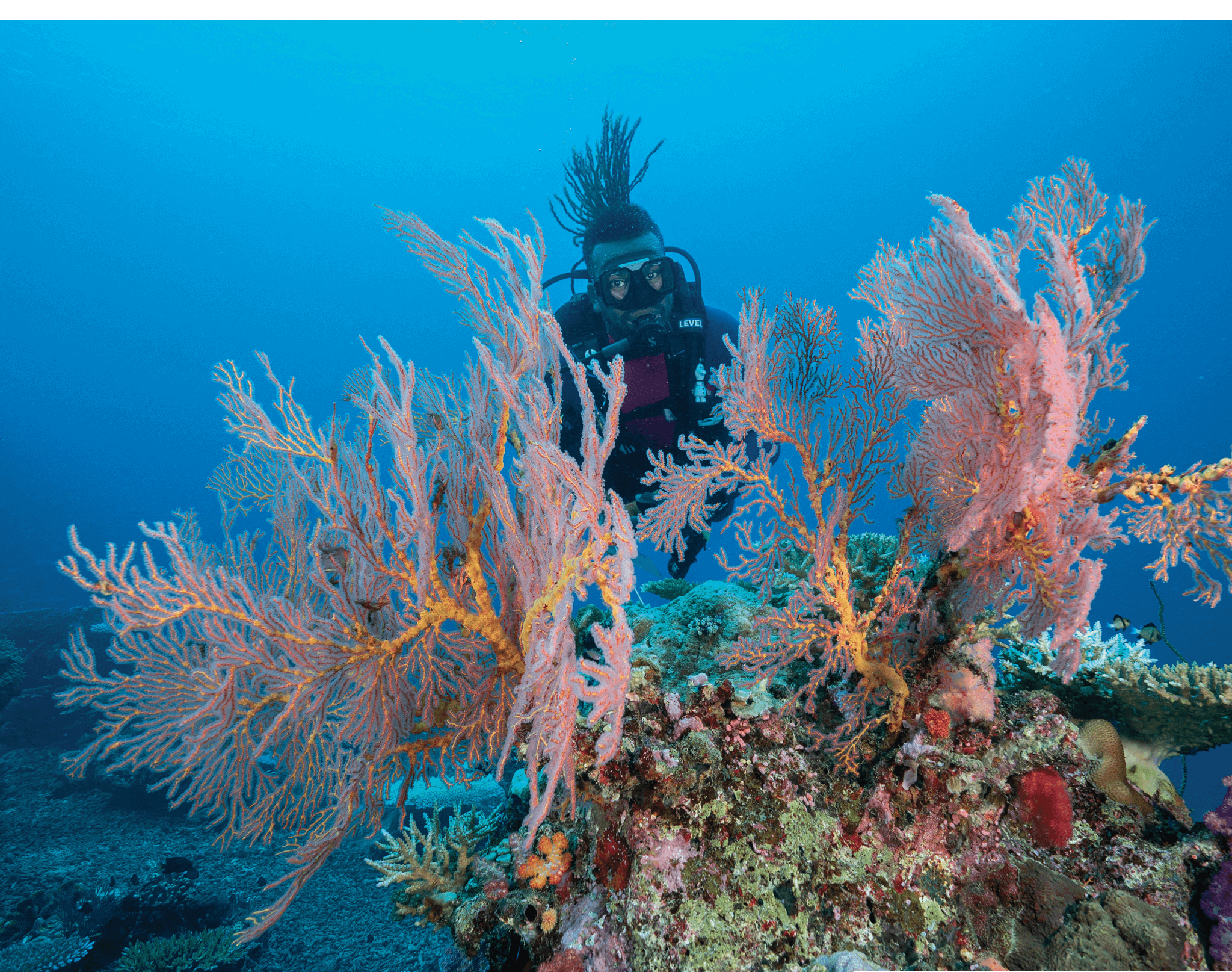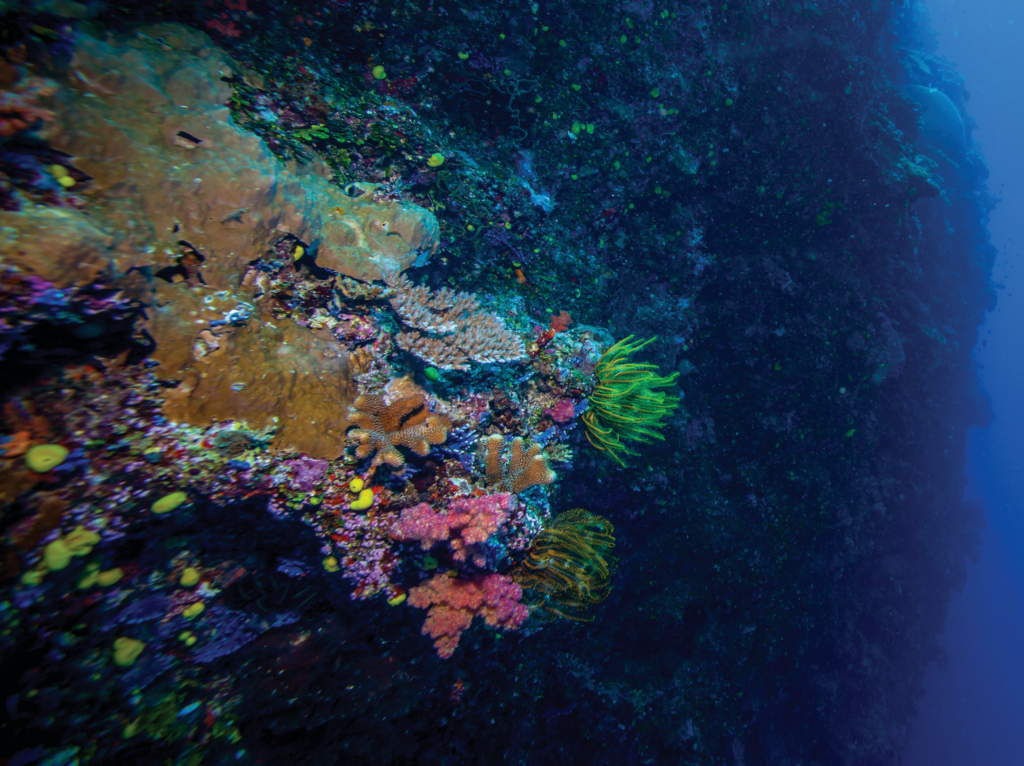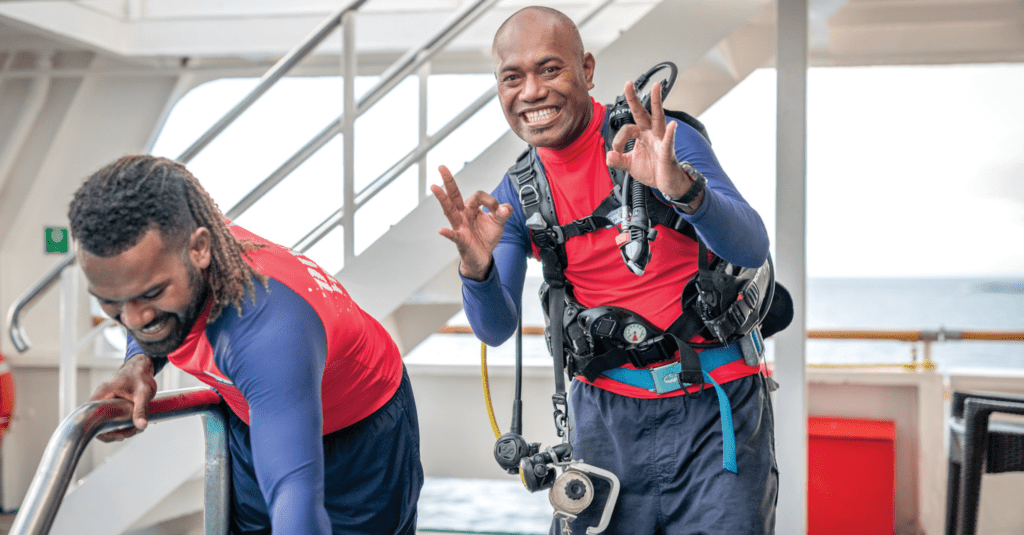Play
All Aboard
Captain Cook Cruises Fiji takes divers where few others can go, in the remote Lau Islands and throughout the Yasawas and beyond.
August 15, 2023
Pacific Island Living
August 15, 2023Fiji is the self-proclaimed Soft Coral Capital for good reason. Thanks to a year-round tropical climate and warm seas nourished by South Pacific currents rich with nutrients, Fiji’s underwater world is spectacular.
Whether you’re an experienced scuba diver descending to great depths or a novice content to snorkel over a coral garden, opportunities abound to view Fiji’s marine life up close and personal.
Some of Fiji’s most spectacular dive sites are in the remote islands of the Lau Group or around Taveuni in the Somo Somo Strait. The Lau Islands are Fiji’s least populated so these dive sites are only accessible by passenger boats such as Captain Cook Cruise’s MV Reef Endeavour.
Fulaga Lagoon is reached through a deepwater channel and offers one of Fiji’s most extraordinary drift dives. Time your drift on an incoming tide (not on an outgoing tide or you’ll end up in Tonga!) when the sea rushes through the narrow pass at up to 6 knots.

Deep below, pelagic species and sharks ride the current in the sandy-bottomed depths while colourful soft and hard corals cling grimly to the reef in the shallows.
Lau’s best dives offered by Captain Cook Cruises according to the onboard team include:
Vanuabalavu Channel – start the dive on the inside and drift outside the channel, this deep wall allows the chance to see pelagic and big fish sightings, visibility very clear.
Fulaga Wall – with a base at 260m and visibility typically at 30m-40m this dive is one of the dive teams favourites and the only disappointment is you can only dive it once.
Vuaqava Pinnacles – mostly hard coral but lots of fish and school of trevally frequent this spot. The safety stop at the top of these pinnacles is a favourite part of the dive for the team.
Kabara: dive starts from the base of the island’s limestone rocks gradually drift out through a maze of coral heads and pinnacles. The visibility typically is at 30m. This site is also offererd as night dive during the cruise.
Totoya: this site is a favourite for both snorkelers and divers alike as this fringing reef comes very shallow and has an abundance of coral, fish and colours.
Kadavu Vunisea Wall: yellow soft corals, deep swim throughs and great clear visibility, a great dive to end the cruise.
Elsewhere, Beqa Barrier Reef has a protected inshore lagoon dotted with islands, many of which have resorts providing access to dive sites, whether diving the shallow lagoon or outer reef walls.
Further south, the Great Astrolabe Reef is a barrier reef which circles Fiji’s fourth largest island, Kadavu, and is known for the large pelagic species along with soft corals which thrive in ocean-washed passages between the outer reef and lagoons.
The Great Sea Reef is the world’s third largest barrier reef (behind Ningaloo and Great Barrier Reefs) which runs near parallel to Vanua Levu’s northern coast.
A World Wildlife Fund survey found that this reef system provides habitat for more than 55% of Fiji’s coral reef fish and over 70% of all Fiji’s known coral species.
Rainbow Reef lies in the Somo Somo Strait, between Taveuni and Vanua Levu, and attracts divers from all over the world.
The Great White Wall with its vertical cliffs cloaked in pastelhued coral gardens is the most well-known, but there are countless others. Swim throughs, overhangs and hard and soft coral gardens line both sides of the deepwater passage. Nearby, barrier reefs surround Qamea, Laucala and Matagi Islands, resulting in lagoon-like offshore diving conditions.
Captain Cook’s onboard dive team also offer an array of courses ranging from Discover Scuba for beginners, to full certification course like the PADI Open Water Course, Advanced Open Water, Rescue Diver and other specialty Courses.

For the rusty diver who hasn’t been in the water for a while, the instructor will offer you a refresher in the pool and buddy with you on your ocean dive.
If you’re looking to get your certification done whilst onboard, it is recommended you complete your theory online via PADI’s E-Learning platform prior to arriving and let the team do the rest onboard.
Dive packages can be organised after you arrive, and this also allows you to choose your sites while able to plan and enjoy other shore activities offered throughout the cruise.
The beauty of diving on a passenger cruise is that everything is taken care of for you. From scheduling to gear cleaning. And what’s more, after your dive, it’s a few steps to your private hot shower, then to the lounge to relax and plan tomorrow’s diving adventure.

© 2024 Pacific Island Living Magazine all Rights Reserved
Website by Power Marketing